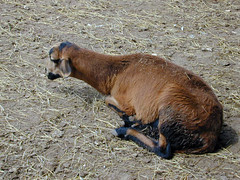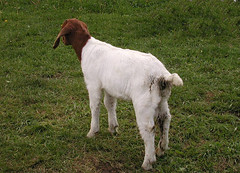 In livestock, diarrhea
is called scours. There
are many causes of diarrhea: bacterial, viral, parasites, and diet.
In livestock, diarrhea
is called scours. There
are many causes of diarrhea: bacterial, viral, parasites, and diet. Flystrike risk
Sheep that have diarrhea are more prone to flystrike (blowflies or maggots). To help prevent flystrike, it is recommended that lambs be docked. However, the tail should not be docked too long nor too short. Feces will accumulate on long tails.
On the other hand, the dock should be left long enough to cover the vulva of the ewe and an equivalant length on a ram lamb. If a lamb can "wag" its tail, it will be able to use its tail to project away feces. Otherwise the feces will run down the lamb's back end. It is usually not necessary to dock the tails of hair sheep or rat-tailed breeds.
Diarrhea in young (neonatal) lambs and kids
Despite improvements in management practices and prevention and treatment strategies, diarrhea is still the most common and costly disease affecting neonatal small ruminants. A study at the U.S. Sheep Experiment Station (Dubois, ID) showed that diarrhea accounted for 46 percent of lamb mortality. Diarrhea in lambs and goats is a complex, multi-factorial disease involving the animal, the environment, nutrition, and infectious agents. The four major causes of diarrhea in lambs and kids during the first month of life are E. Coli, rotavirus, Cryposporidum sp. and Salmonella sp. E. coli scours are most common.E. Coli
E. coli scours is an opportunistic disease associated with sloppy environmental conditions and poor sanitation. It is seen in lambs and kids less than 10 days of age, but is most common at 1 to 4 days of age. It usually presents itself as an outbreak in lambs and kids between 12 and 48 hours of age. It is also called "watery mouth," because affected lambs salivate and have a cold mouth. Fluid therapy is the mainstay of therapy.
Antibiotics are used for both treatment and prevention of E. coli scours in lambs. Spectinomycin oral pig scours medicine is commonly used, though it is not approved for sheep and goats. Ewes and does can be vaccinated with bovine E. coli vaccine before they give birth to increase passive immunity. The use of neomycin in lambs that appear normal may stop the progression of the outbreak. Adequate ingestion of colostrum by newborns decreases the incidence of the disease.
|
||||||||||||||||||
Lambs and kids are infected with a group of B rotaviruses, whereas most other animals and humans are infected with group A rotoviruses. Rotavirus generally causes diarrhea in lambs and kids at 2 to 14 days of age. Young animals become very depressed and dehydrated.
Rotavirus is treated with supportive care. Vaccinating ewes and does with bovine rotavirus vaccines before they give birth will increase passive immunity. Viruses tend to be less a cause of diarrhea in lambs and kids than calves.
Cryptosporidium
Cryptosporidium parvum is a protozoa that can cause diarrhea similar to that of rotavirus infection. Cryptosporidia can cause diarrhea in lambs and kids 5 to 10 days of age. Affected animals are often active, alert, and nursing. The diarrhea is usually very liquid and yellow.
No consistently effective treatment for cryptosporidiosis in ruminants has been identified. Anectodotal reports suggest that decoquinte (Deccox®) and monensin sodium (Bovatec®) may be useful in the control of Cryptosporosis. Ammonia and formalin seem to be most effective at removing Cryptosporidium from the environment. The best control of cryptosporidiosis comes from lambs and kids getting adequate immunity through colostrum soon after birth.
Salmonella
The bacteria Salmonella has thousands of serotypes and all can potentially cause diarrhea in animals. Salmonella can cause diarrhea in lambs and kids of any age. Animals less than 1 week of age are more likely to die without clinical signs, whereas animals older than 1 week are more likely to have diarrhea. Salmonella also causes outbreaks of diarrhea in late gestation and is frequently associated with abortion. Bleach is an effective disinfectant to use during an outbreak. Vaccine efficacy is questionable, and to date vaccination has not been thoroughly evaluated in sheep and goats.
Giardia
Giardia-induced diarrhea is more commonly, but not limited to 2 to 4 week old lambs and kids. The diarrhea is usually transient, but infected animals can continue to shed cysts for many weeks, providing a source of infection for other animals and possibly humans. Infected animals can be treated effectively with fenbendazole (SafeGuard®, Vabazen®).
Nutritional
 Infectious agents are not the only cause of diarrhea in neonates. Nutritional
problems can result in diarrhea. Nutritional diarrhea is most common in
orphaned animals as a result of poor quality milk replacers, mixing errors,
and overfeeding. Consumption of lush pasture or high-energy diets can also
result in diarrhea in young lambs and kids.
Infectious agents are not the only cause of diarrhea in neonates. Nutritional
problems can result in diarrhea. Nutritional diarrhea is most common in
orphaned animals as a result of poor quality milk replacers, mixing errors,
and overfeeding. Consumption of lush pasture or high-energy diets can also
result in diarrhea in young lambs and kids.A scouring lamb or kid loses large amounts of fluids and electrolytes, such as sodium and chlorine. Usually the cause of death in scouring lambs and kids is dehydration and acidosis, or increased body acidity. Whatever the microbial cause of scours, the most effective treatment for a scouring lamb or kid is rehydration by administering fluids.
Diarrhea in older lambs and kids
The most common causes of diarrhea in older lambs and kids are coccidiosis and gastro-intestinal parasites (worms). Other major causes of diarrhea in older lambs and kids are clostridium perfringins, rumen acidosis, and nutritional.Coccidiosis
Coccidosis is a protozoan parasitic disease that is a common cause of diarrhea in lambs and kids. It may also cause subclinical production losses. Lambs and kids are most suceptible to the problem at 1 to 4 months of age, although younger animals may be affected. Lambs are resistant to the disease in their first few weeks of life. Exposure to the protozoa during this time confers immunity and resistance to later infections.
Clinical disease is common after the stress of weaning, feed changes, or shipping. The diarrhea of lambs and kids is usually not bloody, but it may contain blood or mucous and be very watery. Treatment of affected animals includes supportive care and adminstration of coccidiostats. All animals in a group should be treated during an outbreak. Prevention involves improved sanitation and the use of coccidiostats.
 Gastro-intestinal
worms
Gastro-intestinal
wormsThe Barber pole worm (Haemonchus contortis) is the major worm species affecting sheep and goats in warm, moist climates that experience summer rainfall. It is not characterized by diarrhea. However, heavy loads of other gastro-intestinal worms can cause diarrhea in sheep and goats: Ostertagia circumcincta (medium or brown stomach worm), Trichostrongylus (bankrupt or hair worm), Coopera sp. (small intestinal worm), and Nematodirus sp. (threadneck worm). Control of gastro-intestinal parasites is best achieved via good pasture, grazing, and animal management, and strategic and/or selective deworming of affected individuals with effective anthelmintics.
Clostridium perfringins
Clostridium perfringins types A, B, C, and D can all cause diarrhea in lambs and kids, though type D is the most common agent. With type D, the onset of neurologic signs followed by sudden death is more common in sheep, whereas goats are more likely to show signs of diarrhea before death. Treatment is rarely effective but consists of aggressive supportive care and administration of the antitoxin.
Clostridium perfringens type C tends to affect very young lambs (<2 weeks of age) and presents itself as bloody diarrhea, hemorrhagic enteritis, and bloody scours. Clostridial diseases are easily prevented in the young by vaccinating pregnant dams about three weeks prior to delivery and subsequent vaccination of offspring. Consumption of adequate, high quality colostrum is important.
Rumen Acidosis
Acidosis is caused by too much grain or concentrate, which causes a change in rumen acidity and bacteria population. The increase in acid causes an inflammation of the rumen wall and a reduction in the bacteria needed to digest fiber. Symptoms may include depression, off feed, bloat, founder, scours, and occasionally death. Treatment includes drenching with mineral oil or antacids. Acidosis is prevented by proper feeding management. Concentrates (grain) should be introduced to the diet slowly and increased incrementally to give time for the rumen to adjust.
Nutritional
Nutritional scours can be caused by anything that disrupts normal habits. It can also be the result of low intake of dry matter to fluid ratio. A lamb needs to consume at least 2.5 percent of its body weight in dry matter daily. Young or fast growing lambs turned out to pasture must eat large quantities of grass to satisfy their nutritional needs. Green grass is high in moisture. They may develop diarrhea if they aren't getting enough dry matter in their diet.
Diarrhea in adult sheep and goats
Adult-onset diarrhea is less common than in lambs and kids, but nevertheless is possible. Parasitism can cause diarrhea in adult sheep and goats. Coccidiosis can occur in adults under extreme stress or due to lack of immunity. The ingestion of toxins, of which the list is long, can also cause diarrhea. It is not uncommon for sheep or goats to scour when they are grazing lush or wet pasture.Johne's Disease (pronounced "Yo-nees")
Unlike cattle, diarrhea is not a common symptom of sheep and goats infected with Johne's disease. A USDA-APHIS study showed than less than 20 percent of sheep and goats with Johne's show diarrhea. Johne's disease is an incurable, contagious bacterial disease of the intestinal tract. It occurs in a wide variety of animals, but most often in ruminants. Johne's is most commonly reported in dairy cattle, but probably underrated as a problem in small ruminants.
Home remedy for scours (WORKS FAST)
1 Quart Water
2 tablespoons Corn Syrup
½ teaspoon Salt
¼ teaspoon Baking Soda
How do you use the scour remedy? Instead of or in addition to regular feeds (for bottle-fed lamb)??
ReplyDelete